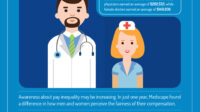When patients negatively review their U.S. health providers, most cite their clinicians’ poor bedside manner or the front desk staff’s rude customer service. Persons of color, lower socio-economic status, or those with limited health literacy or English language skills may be even more dissatisfied or disengaged. What steps can healthcare professionals take to deliver more culturally competent and accessible healthcare?
Cultural differences make it difficult for many to receive the care they need. For example, in a California-based patient study, Spanish-speaking respondents were significantly more dissatisfied with their medical care than dual-language Latino patients and non-Latino (white), English-speaking patients. On the east coast, in a survey of five urban emergency departments, only 52% of non-English-speaking patients were satisfied with their hospital’s emergency care (as compared with 71% of English speakers).
3 Steps to Deliver More Culturally Competent and Accessible Healthcare
- Go beyond the EMR for patient demographics: America is growing more diverse, and the local, county or state demographics can shift within a three-year period. According to the U.S. Census Bureau approximately 21.6% of Americans speak a language other than English at home. Among those, approximately 8% self-report that they speak English “less than very well.” Meanwhile, the National Center for Educational Statistics reports that 21-23% of adult Americans rank in the lowest level of literacy skills – such as those required to read and understand basic healthcare instructions and information. There is some statistical overlap between second language, lower literacy, low-income and uninsured Americans—plus those with chronic health conditions that require frequent medical services. Who lives and works within your service area? Check your hospital’s most recent Community Benefits Report or consult the USDA’s county-by-county data sets. Also, do all your colleagues—including you—know how to contact your facility’s professional translation or language access services?
- Avoid ‘clinical speak:’ In a study of 249 adults—50% of whom were college-educated–nearly 80% of hospital patients did not understand that “hemorrhage” meant “bleeding,” “myocardial infarction” meant “heart attack,” or that “fractured” meant “broken.” Collaborate with your patient-education or marketing departments to create accessible patient education materials (PEM). Find guidelines and resources—including the recommended grade-level for writing PEMs –at U.S. Minority Health and Centers for Medicare and Medicaid Services’ websites. Finally, know the U.S. Department of Health and Human Services Office of Minority Health’s 15 national CLAS standards for culturally and linguistically appropriate patient services.
- Address Implicit Bias in Healthcare: In a University of Albany School of Public Health study, many physicians and nurses self-reported their auto-assumptions that their patients who were African American or lower income were more passive, less intelligent, more likely to engage in risky behaviors and less likely to adhere to aftercare plans (than white or middle-class patients). Also, health-disparity reports from the Institute of Medicines and the Agency for Healthcare Research and Quality revealed that African Americans were more likely to receive sub-par medical care.
At your school or health system, how are you training about race-based implicit biases or addressing microaggressions in medicine among or against your students or colleagues? Start by examining your own biases by taking the Harvard University Implicit Bias Test.
Even as America’s population grows more diverse, over 50% of practicing physicians are white. There is a persistent lack of racial and linguistic concordance between patients and their healthcare providers.
Among those negative online physician reviews, many patients cited providers’ apparent indifference and poor listening skills. From the front desk to the clinical encounter to aftercare instructions to billing, these are baseline and best-practice skills that can make it easier for your facility to deliver culturally competent and accessible healthcare.




